After 9 hours of uninterrupted sleep and a rich brunch, the world didn’t turn rosy, but I could finally think straight.
I have sailed between and near the Cape Verde Islands several times but never set foot ashore, except for the one time I flew to Durban, South Africa (to deliver a Crealock 37’ solo, back to USA), and the plane landed for refueling here between New York and Johannesburg.

Emergency anchorage at Cape Verde Islands
Wind vane repair on anchor after 3 weeks manual steering
My friend Jimmy Cornell recommended Mindelo Marina on the island of Ilha de Sao Vincente as a suitable place to get my wind vane replacement. Mike Scheck, who distributes the Monitor and is the owner of Scanmar International, offered me his wind vane (Monitor) free of charge as a patriotic help; he only asked for reimbursement of the freight fee.
Of course, the communication related to the transaction took place through the mediation of the GGR tournament organizer—mostly Don—with a delay in the different time zones of the parties involved (the Monitor is made in California).

With my close friend -Jimmy Cornell- in Annapolis Boat Show

And his autographed gift…
And, of course, timing played a key role here, as in any other area of life.
I wistfully remembered when I was sailing from New York to England—where I encountered the Windpilot problems – I asked my team captain, Ian, to inquire about shipping a Monitor to England. Unfortunately for me, Ian had just moved into his new house, and due to his busy schedule, the vane replacement couldn’t happen at that time. Now, I had to wait five days for the Monitor to arrive, so I immediately looked for another solution.
I dug out the spare parts of my Windpilot, including a complete spare unit. Peter generously gave one to all his sponsored entrants. I began comparing “apples to apples,” so to speak and began exploring the differences.

Windpilot wind vane and its spare one
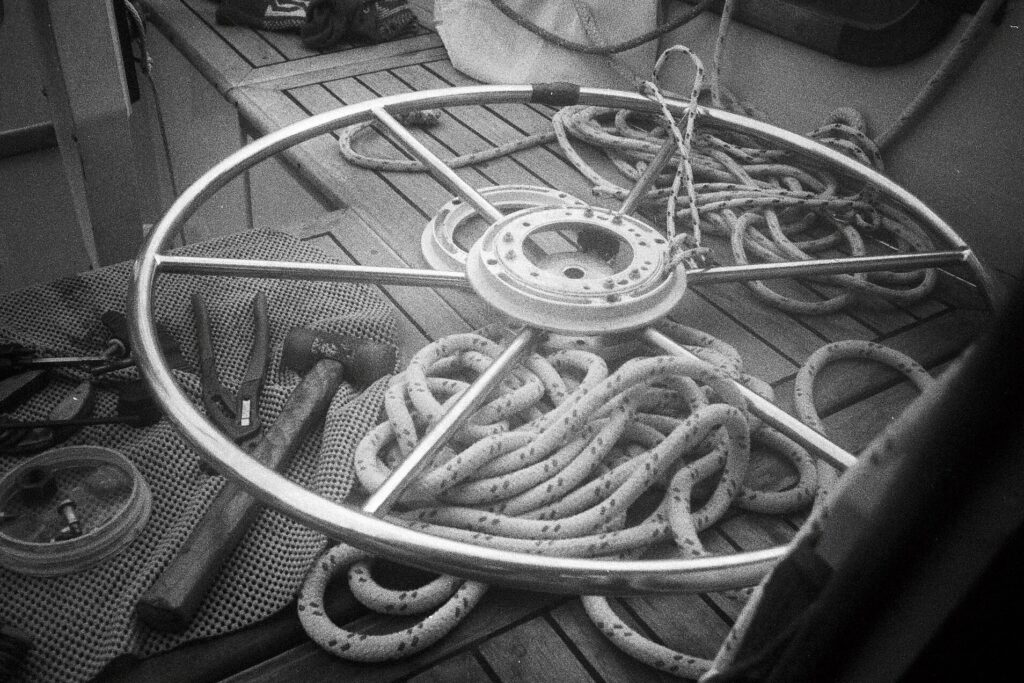
Puffin’s real troublemaker was the Windpilot wheel adapter
I was relieved to see that the pendulum tube was only sliding down due to loose stud bolts, an easy fix. And I was even more pleased to discover that when Peter serviced the steering wheel adapter (before the start), he had accidentally forgotten to put back the three bolts (socket head cap screws) of the right inner ring. (My detailed review of the Windpilot will explain all the related issues discovered during the race.)
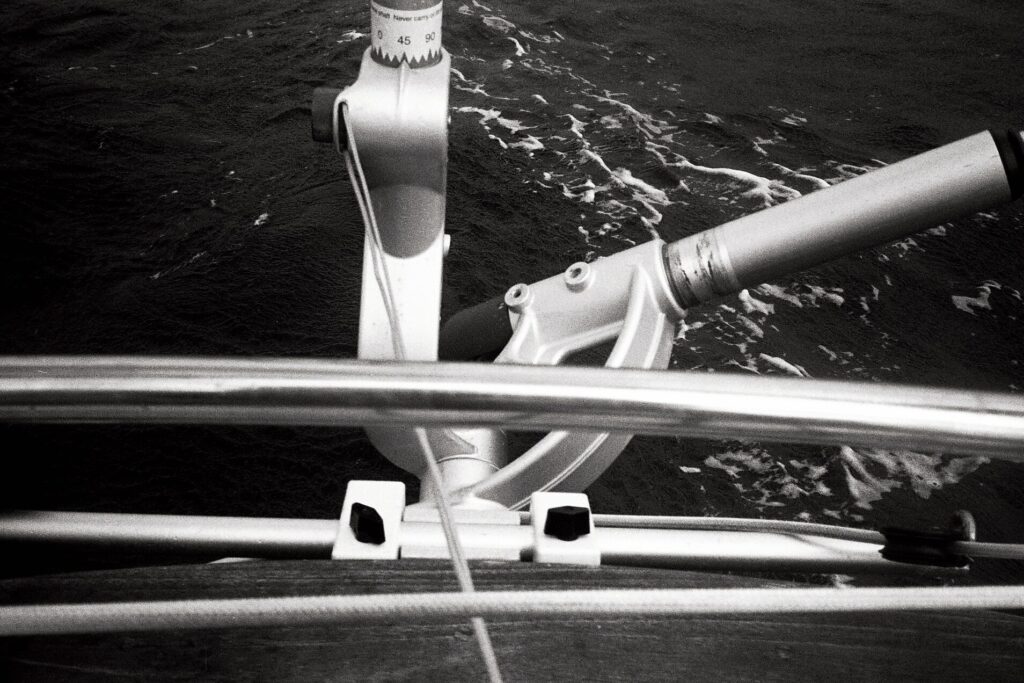
Reinstall the slid out pendulum tube…
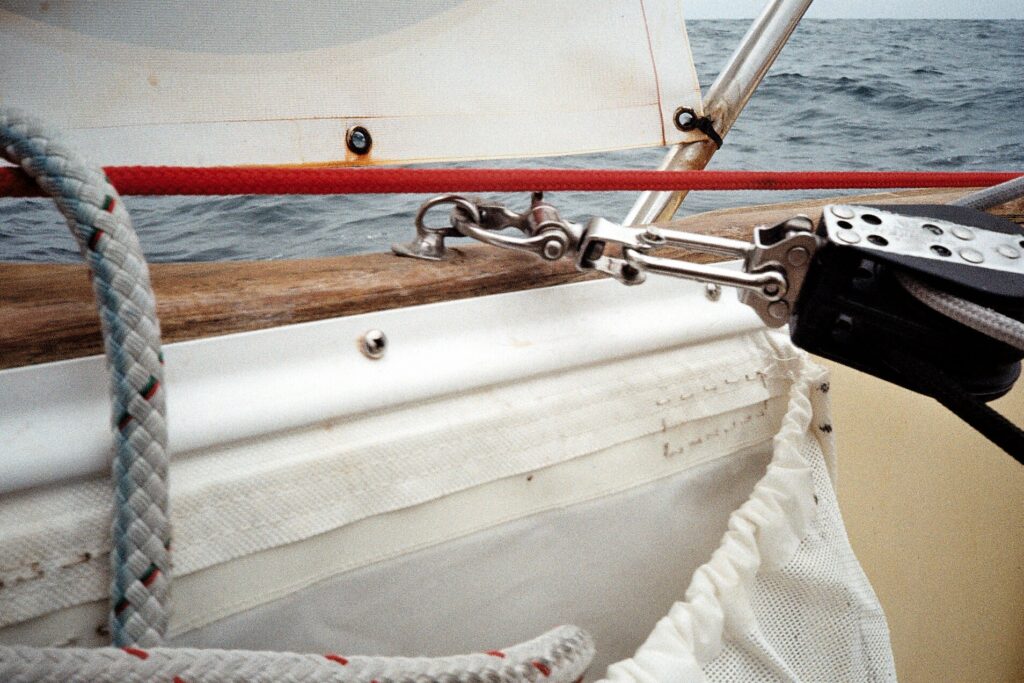
…and replace the deformed eyebolt are easy fix

But the wheel adapter never ceased causing problems
I replaced the forgotten screws from the spare and reassembled the wind vane- refastening all its screws. I asked Don to cancel the new unit’s shipping just in time.
The success of my work pushed me further, and I installed the Windpilot’s connecting fittings on the emergency tiller, too.
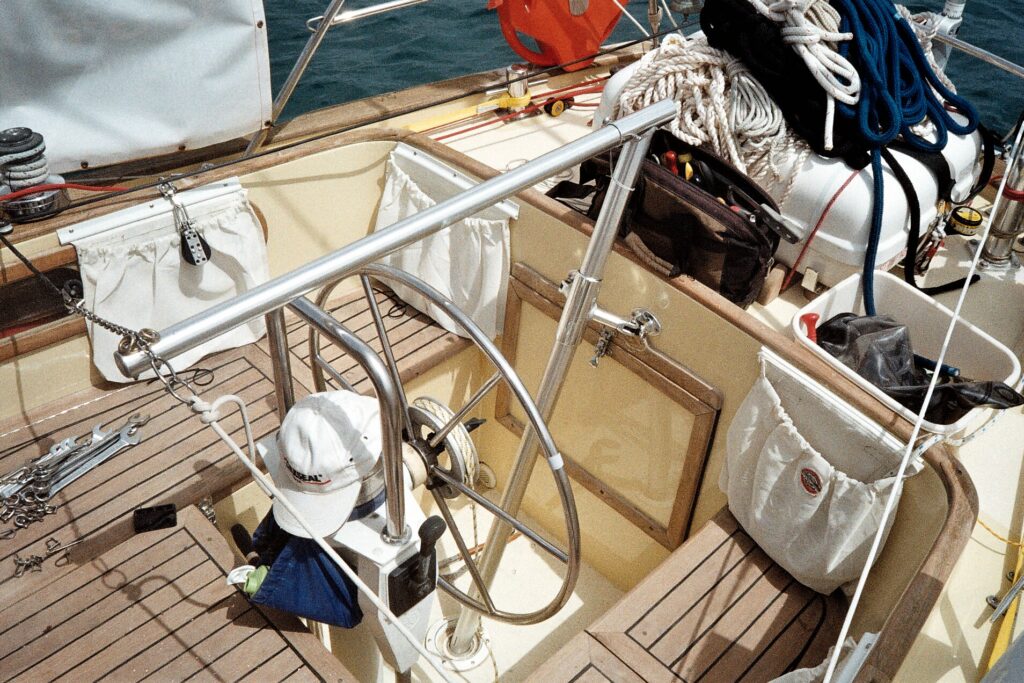
Preparing the emergency tiller for the wind vane
Then I started troubleshooting the water generator, a Sailgen. The control panel had issues. And, at last, I sealed the leaking deck hatches.
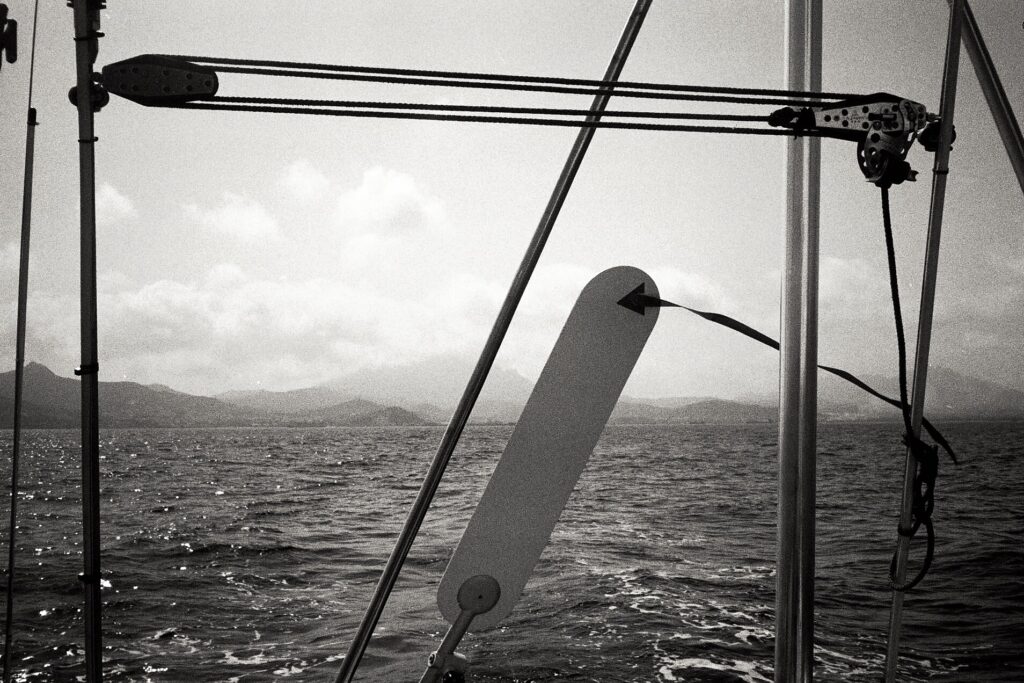
Leaving Cape Verde Islands behind
I departed from the anchorage at 10:30 on July 24th, after a 31.5-hour-long stop, and joined the race—eager to catch up with the GGR fleet as I had not gotten any outside assistance.
There is no pleasure without a tincture of bitterness; Don degraded Puffin into Chichester class with no acceptable reason. I had stopped in a naturally sheltered anchorage; I had not used any outside assistance during my repair. And I had communicated via the race management on the designated channels, according to NOR.
I called Don’s phone on the instructions of the race director on duty (since he was not available on the GGR “red line, which any entrant could call at any time).
Due to the handicap caused by the wind vane, I ended up in the trailing end of the fleet. Which in itself was very frustrating, and now this came— the last drop in the overflowing cup—the unjustified race director’s procedure.
The light winds did not help Puffin’s progress either, although I did my best to get out of the wind shadow of the high volcanic islands as soon as possible.
July 26 brought several surprises: the first was the good news that Puffin returned to the GGR field after clarifying the circumstances. However, I received a 24-hour penalty time for reasons unknown to me. As another surprise, I came across a Brazilian deep-sea drilling rig stationed quite far from the islands. Luckily during daylight hours.
The last days of July, mostly with light breeze, and the never-ending fields of sea grass made for a depressing trudge, while on the last day of the month, the mainsail halyard that snapped in a 35-knot thunderstorm and the unruly wheel adaptor again forced Puffin to “heave to” for repairs.
The second month of the competition, August, brought more consistent trade winds and a huge improvement in our radio connection. Tibi Németh and the Hungarian radio amateurs mobilized by him not only transmitted the exact time needed to calibrate my chronometer but also István Méder’s weather reports to Puffin. As an excellent radio amateur, Tibi reached almost every day. Although he did not know much about sailing, the regular radio contact made it much easier to bear the loneliness.
On August 4, I noticed the first barnacles on the bottom of the boat, an area above the Seahawk antifouling paint, near the stern. I spent almost an entire day sorting and loading the heavier stuff in the bow to get Puffin’s ideal trim.
On August 6, we crossed the equator. Puffin for the first time, and myself for the 14th time. I was able to shoot the sun and moon, my favorite heavenly body, simultaneously confirming our crossing on the Zero Latitude.
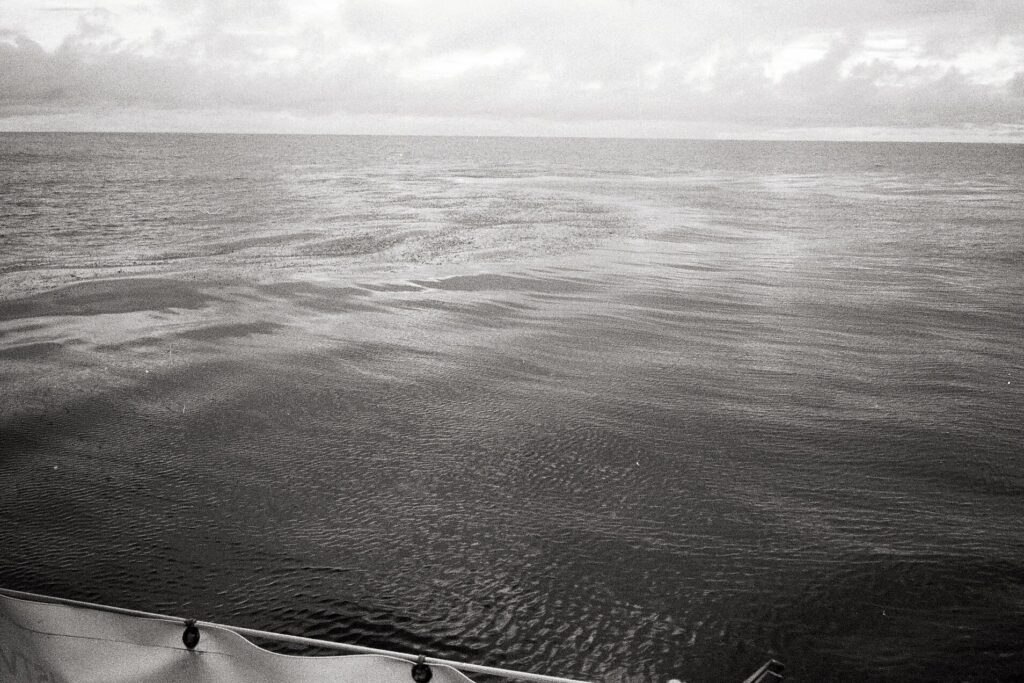
Visible Equator or just the current?
On August 8, I became aware of new problems. My smaller SS (stainless steel) potable water tank ran out of water, and to my surprise, the original fiberglass laminated water tank was contaminated and was clogging the pump’s prefilter within a few minutes.
Before coming to me, Puffin was abandoned on the hard for almost 10 years, so preparing it for the competition was an almost 3-year, exhausting task in all aspects.
See my three -year refit here https://koparsailing.com/puffin-yacht-restoration/
There was a customized holding tank (sump tank) built above the inspection plate of Puffin’s water tank since the boat was used on the heavily preserved water of Lake Champlain, New York. First, I had to demolish and remove this holding tank to access the water tank. But, still, the cleaning process, without cutting the tank fully open, was limited to soaking, rinsing, and vacuuming. I did use chlorine and vinegar and rinsed the tank several times. I even put an antifungal quartz lamp into it during winter storage before closing its inspection plate.
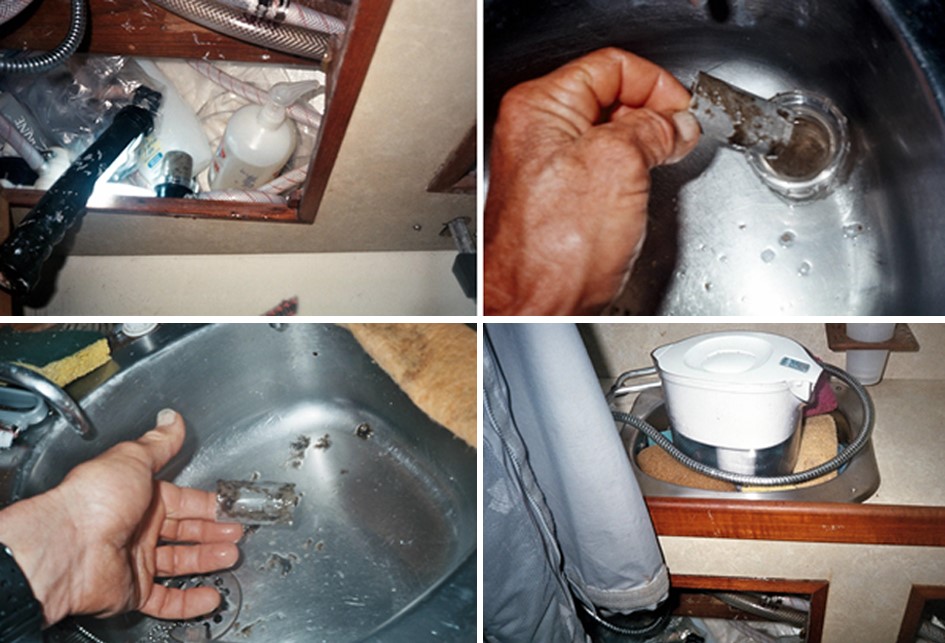
The contaminated drinking water needed constant filtering
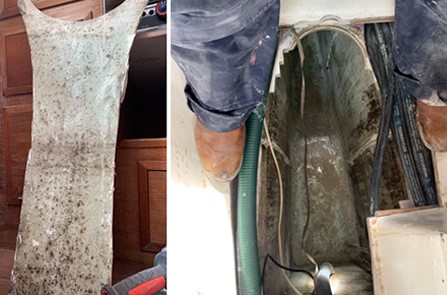
The final solution was to replace the moldy water tank after the race. Credit to Ian Herbert Jones (Puffin’s new owner)
The new custom-made SS water tank replaced the old holding tank, and I was able to cross the Atlantic with only its 37-gallon capacity. I saved the good quality well water from Oyster Bay (NY) in the main tank for the race.
It was a mistake, obviously. During Puffin’s constant sailing—frequently in rough seas—the tanks acted like a washing machine, removing the deposited sediment from the walls of the old tank.
The only access to this tank was in the head via a foot pump, so I kept a water filtering bottle in the sink to make the water drinkable. I had to free up the clogged foot pump filter after every few gallons.
The water treatment got even worse and more time-consuming after Puffin’s knockdown. When the water filtering bottle got damaged, I had to boil the water for drinking.
The water issues might make this chapter “dry” regarding humor. And I certainly wish Puffin’s forepeak (chain locker) had been dry. Unfortunately, it was leaking
When rebuilding Puffin, I replaced all elements of the bowsprit, including the bobstay and its champ plate. However, the port spreader of the Selden mast was damaged during the ocean crossing before the start, and in connection with its replacement, the mast was re-tuned several times in England and France.
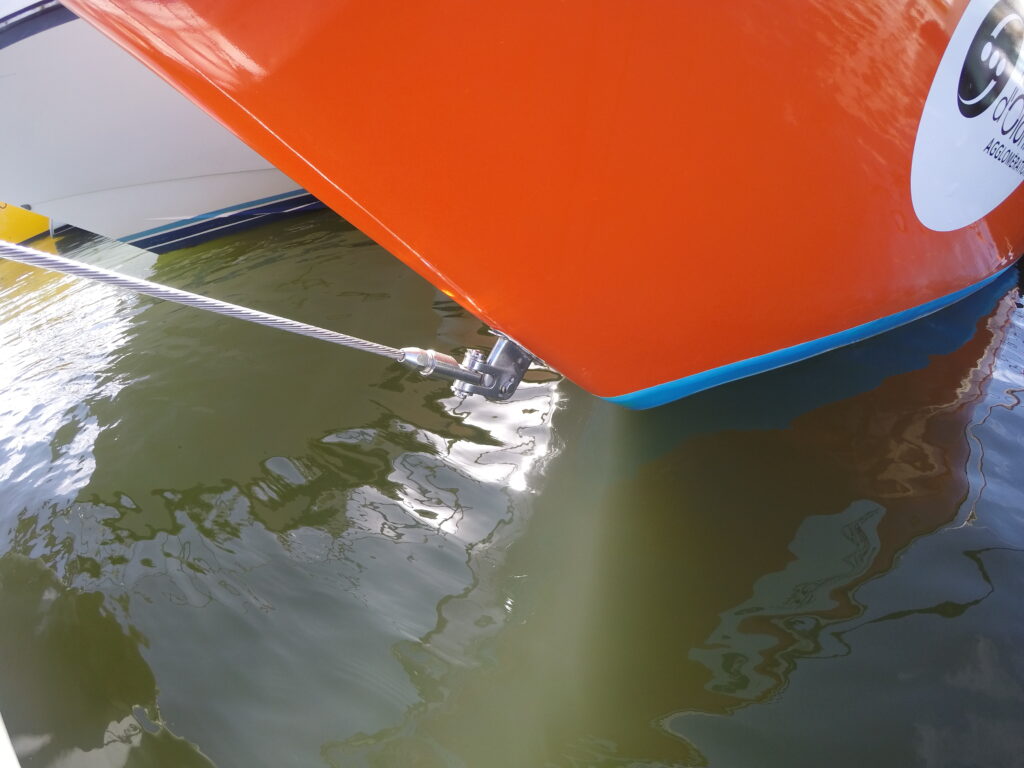
The bobstay chain plate got loose and started to leak
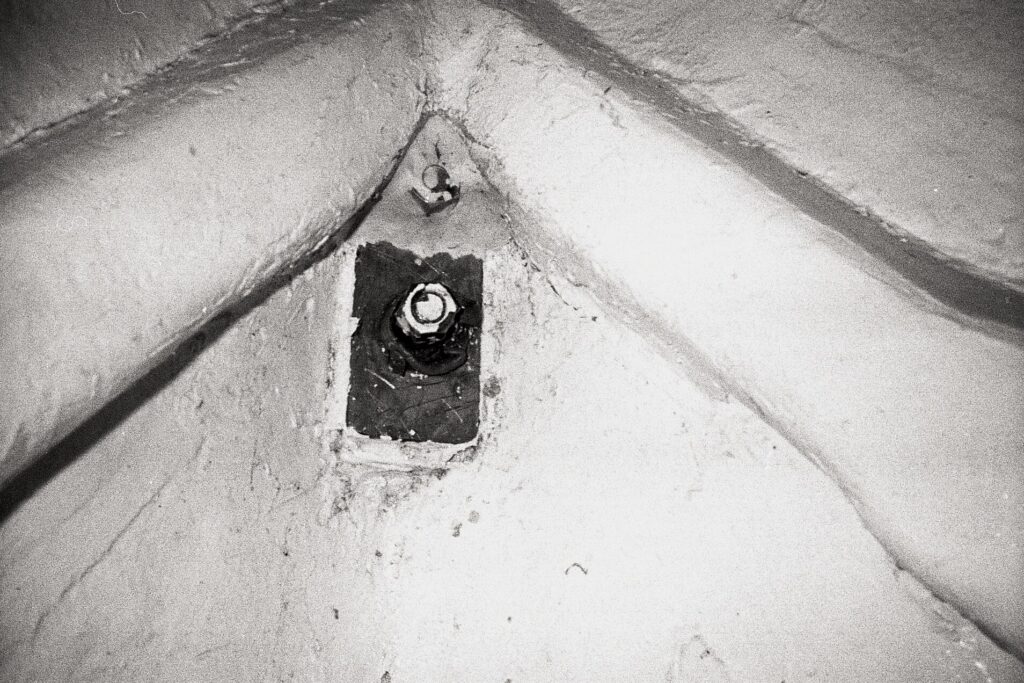
I epoxied the counter plate around ( inside the chain locker) after tightening the bolts
However, the bobstay was never touched, so no one noticed that its chain plate, which is almost at the waterline, had loosened due to the various loads.
This fitting started to leak more water a couple of days ago when I changed Puffin’s trim. I also noticed the clumsier motion of the boat and the slackened forestay, too.
Luckily, I emptied the forward cabin above the V bunks before I opened the watertight door of the forepeak so that the accumulated sea water in the chain locker flooded only the storage below the bunks—causing little damage to my well-packed food supply.
But the seriousness of the water leak became visible after snaking myself into the tight chain locker and shining my headlight around.
Due to the narrow space, the loose screw nuts of the mainstay could only be tightened with a special socket wrench, but for this, it was necessary to loosen the two backstays. Which, due to the state of the sea, I could only do by heaving to once again—again slowing Puffin down—so my chances of catching up with the field worsened even more.
I didn’t really want to repeat the difficult work of doing yoga and sauna at the same time in the tight space with the constant elevator. Therefore, as a precaution, I used Puffin’s sealed anchor chain tube. I ran a rubber hose with a narrower cross-section into the deepest bilge in the middle of the boat, where it was much easier to remove the seawater.
The intense work until August 11 exhausted me both physically and mentally, so after shifting Puffin into her race gear, I took a break and read for the first time in the race—two short, entertaining novels from Jeno Rejto (the Hungarian PG Wodehouse). Combined with a cockpit bath, I was recharged and ready for the next battle.
The importance of timing got highlighted again by Ian’s advanced logbook note: “Hi Istvan, Stay focused, Stay safe, Stay fast. Always push! Ian” He wrote this note into Puffin’s logbook by God-given foresight predicting its perfect timing while we sailed together from Falmouth to Sable d’Olonne.
By mid-August, we left behind the puffy trade wind clouds and entered the Horse Latitudes. Using one of its calms as an opportunity to take care of recently accumulated maintenance work, I climbed the mast to replace the snapped main halyard.
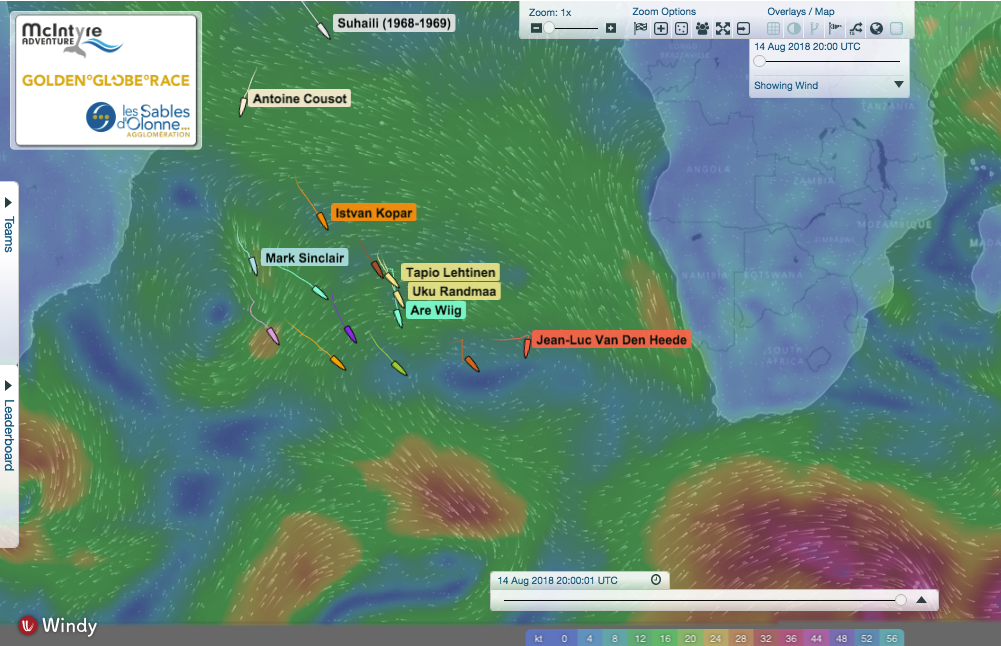
Puffin was herding the fleet at its tail due to wind vane problems
The windless days on the sea are rarely “waveless.” The English term “calm” might be misleading for “landlubbers,” suggesting smooth, flat, motionless water surface, which can occur on smaller lakes, and inland waters. On the ocean, the wind-generated waves travel far (and fast) from their birthplace, showing up as swells even in windless areas. And working on the mast top while constantly rolling 2-4 meters back and forth is always challenging for solo sailors due to potential injuries.
I loved and appreciated Puffin’s new Selden mast from the very beginning. It was well designed and built thanks to Selden US in South Carolina. But the main halyard got chafed frequently just under the masthead despite never hoisting the main above the designated (marked) hoisting height. I had to climb the mast six times in this race, and one of them got me really close to a bad ending.
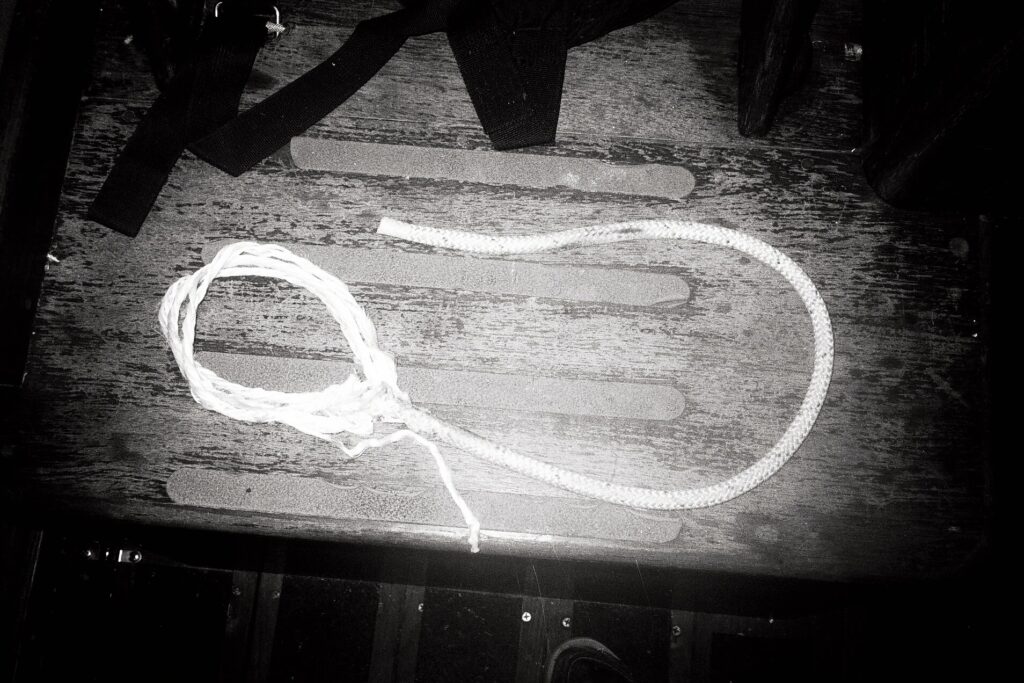
Halyard chafe forced me on the mast top several times

Injuries but minor ones, luckily
Trouble, as we know, also likes company, and the toilet door got stuck at the worst time.
The head door has its own history in our GGR since most entrants requested its removal due to the feature of solo sailing. But Don stayed firm and did not bend, protecting the characteristics of mass production boats (as per his NOR). Puffin’s head door story was a long one, as her deck stepped mast compressed the door frame via the dented deck due to a mislocated compression post (during her building) and made the door openings rubbish.
Luckily, I offset this problem on time by expanding the supporting surface of the post during the installation of the new Selden rig. But we put an additional load on the deck during our last mast tune (just before the start) when the mast got bent, preparing for heavy weather, and the door started to rub the frame again.
On August 19, the door finally got firmly stuck, so I removed it for safety reasons and attached it to the inner wall of the head (washroom). A solid mahogany door is not only a masterpiece of carpentry but also as heavy as lead. I would have gladly left it on the beach in exchange for extra drinking water equal to its weight because I had not yet had the opportunity to collect rainwater.
On reaching the South Atlantic Ocean, the winds increased, and the temperature gradually decreased, but in an unusually different pattern. The storms got shorter,the calms longer, and they frequently shifted, confusing the wind indicator, the thermometer, the sea, and me.
Calms slowed us down, but I started appreciating them as Mr. Murphy joined us as an illegal crewmember and labored diligently. He ruined the control panel of the propane stove by the end of the month, this ended the accidental gas leak alarm via its sensors.
The water boiling process got much longer now as I had to reach out into the cockpit to open & close the gas cylinder. Plus having to vacuum the main bilge occasionally to prevent the accumulation of any leaking propane. But thanks to my foresight, I installed an ignition-proof air vent with a long flexible air hose in the cabin, minimizing the chance of transforming Puffin into a spaceship in case of an accidental gas leak.
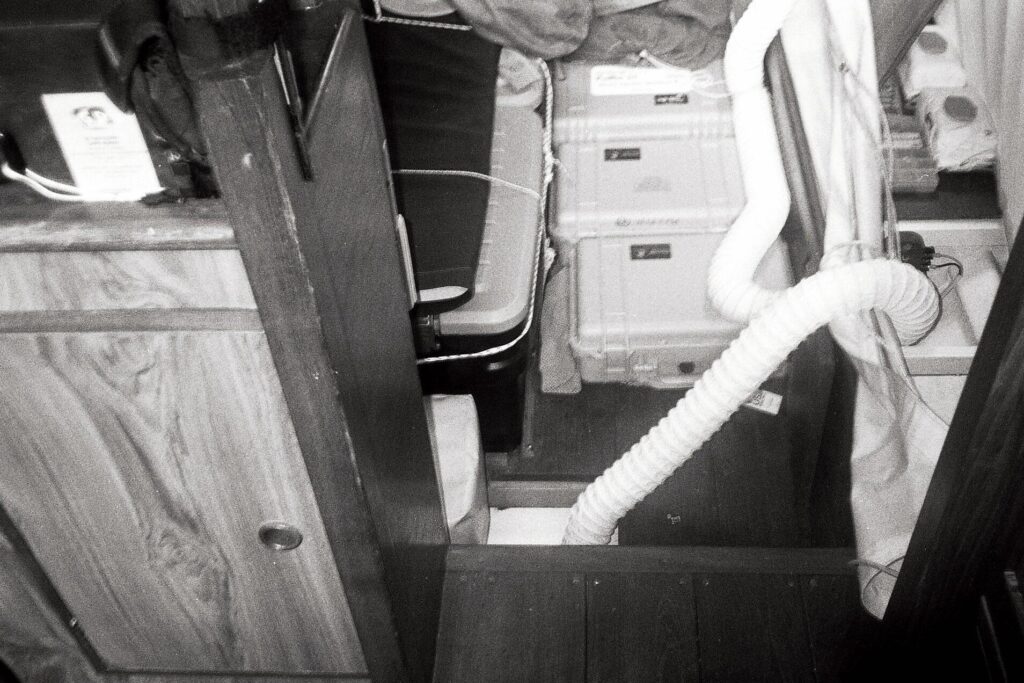
Ignition proof air venting of the deep bilge
However, my latest point of pride became the unique reinforcement on Puffin’s cap shroud. During the daily inspection, I found a little cut on one of the strands of the port cap shroud. It was a small one, indeed. But it captured my mind sailing towards the Roaring Forties as a shroud strand broke during my 1st solo circumnavigation— luckily close to the finish.
But this time, the most challenging part of the voyage was ahead of us, and the rig’s condition came 2nd in my priorities after maintaining Puffin’s flotation.
The ding on the shroud was close to deck level, about 5 feet high, and the spare bobstay was long enough to offset the load. I connected the swaged terminal end of the bobstay to the cap shroud above the damaged spot with three wire rope clamps (SS), while the other end, with turnbuckle, got connected to Puffin’s additional chainplate (above the deck) with a matching shackle.



Cap shroud reinforcement with the spare bobstay
Drilling through the thick SS chainplate took some time and effort. But I felt childish pleasure while I was tightening the bobstay’s turnbuckle and offsetting the load from the damaged section. Symbolically, I tapped myself on the shoulder for Puffin’s heavy but seamanship-like inventory.
Just as I finished this project, Are, our Norwegian competitor, just ahead of us and further south, lost his mast on August 27th.
As a pleasant surprise, despite Mr. Murphy’s best efforts, Puffin’s initial disadvantage steadily decreased, and I managed to get in VHF contact with Tapio (Finnish competitor). (Marine VHF radios work on a line-of-sight basis.)
September greeted us with a serious storm, not unusual for the season since this is still late winter-early spring in the Southern hemisphere.
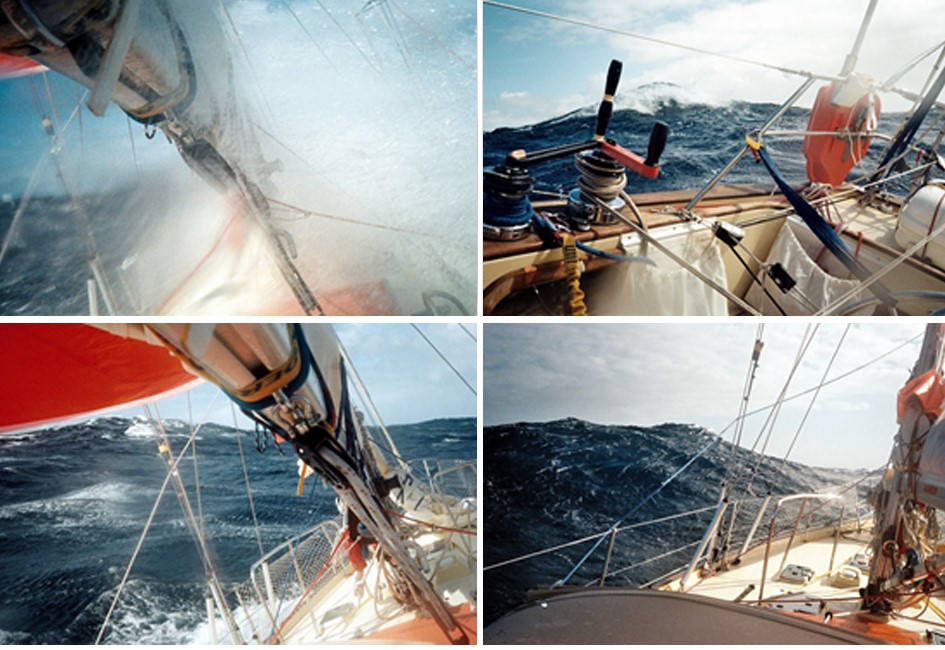
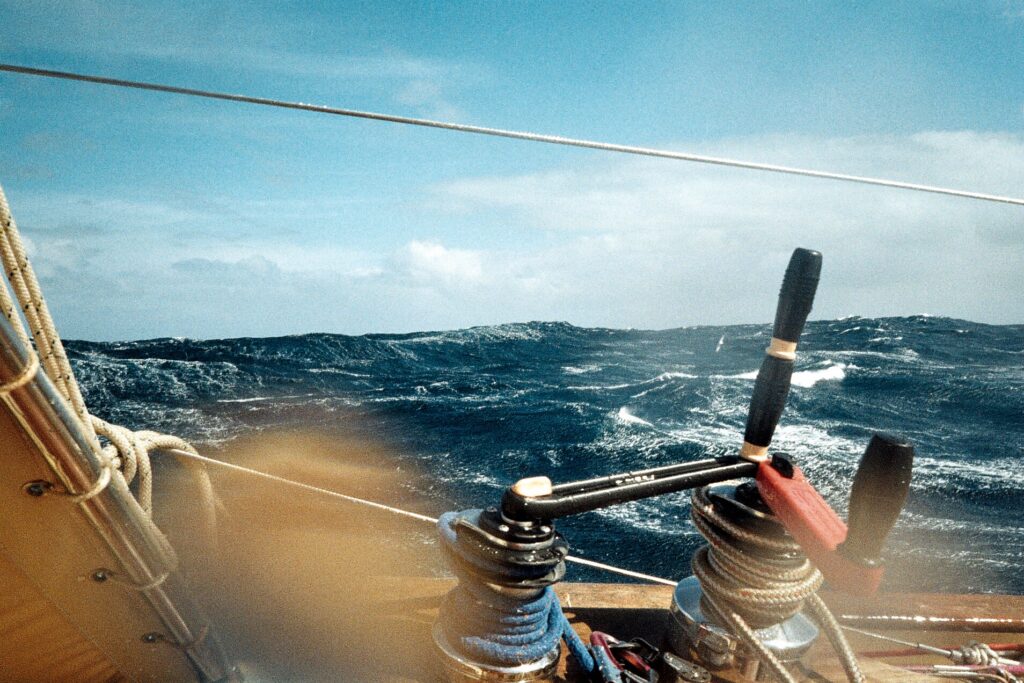
Weather is getting nasty
The heavy weather made the wheel adapter unreliable—again forcing me to manual steering. I used a C-clamp to keep the sliding discs engaged during my short breaks, but I had to lash them together for longer ones—like having a nap—which made the quick disengagement difficult in an emergency or for adjustment on heading.
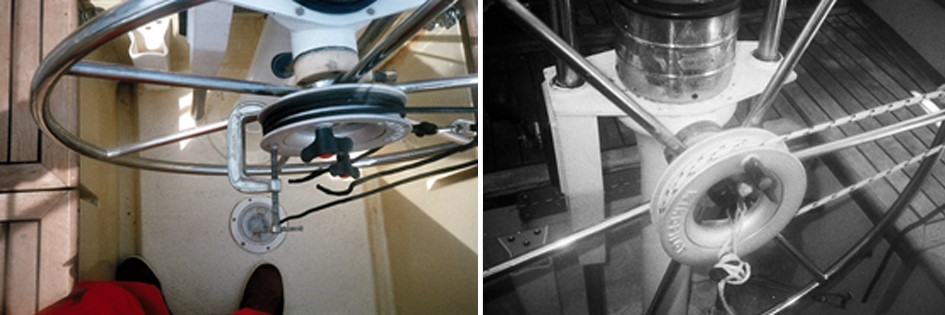
Temporary solutions (C-clamp or lashing) to lock the constantly failing wheel adapter
On September 3, Puffin was still in 8th place, but the next day Tapio overtook me again due to my trouble with the wheel adapter. To change the brake pad of the adapter, I always had to remove the steering wheel and shackle Puffin in a “heave to” to install it.
On September 4, a storm strengthened to 50-60 knots from NY-SNE, building waves 10-12 meters high, which alternately pounded Puffin’s side like a battering ram, and sometimes filled the cockpit like a waterfall. Everything on the ship became wet, inside and out. Meanwhile, the temperature in the cabin had already dropped to 10 degrees C. The force and size of the waves became so terrifying that I even installed Outland PVC shading sheets on the windows to dampen the force of the crashing waves.
By September 6, the storm had subsided, but it left chaotic conditions behind and took Puffin’s stern light with it. Bailing and tidying up were followed by sealing the newly discovered onboard leaks and drying out the water-soaked stuff.
Of course, I tried to get Puffin to a faster pace hoping to catch Tapio, again.
On September 9, I caught up with Tapio. And for the first and last time during the race, we sailed side by side for hours within sight. It was a short but enjoyable time because Tapio generously shared the news of the race and the outside world on the VHF. I was surprised that he had daily—sometimes twice a day— radio contact with Finnish radio amateurs, who apparently informed him about everything, even the daily political current affairs.
On September 10th, we were already sailing in the Southern Indian Ocean ahead of Tapio and out of VHF range.
I was very exhausted, but we set our sights on the DHL boat 200 nm ahead of us, hoping to have the next chat with Susie…
To be continued….


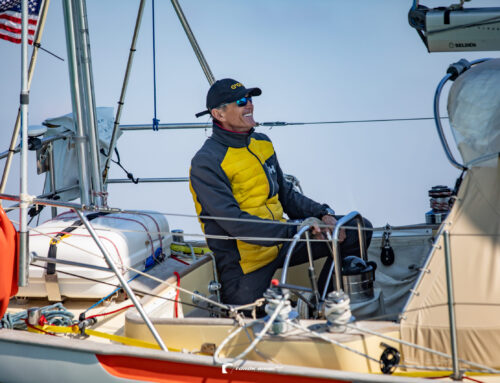



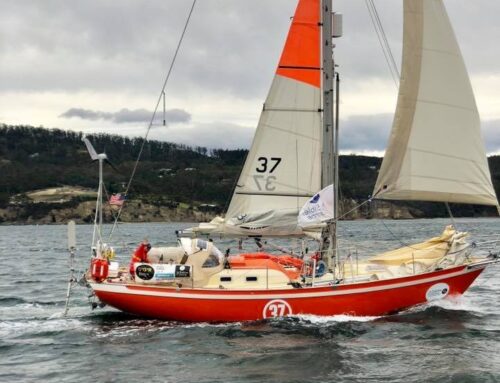
Istvan, thank you so much for taking time to explain your GGR challenges on Puffin, it is awe inspiring. I just bought a TW35 and within the next 5 years I hope to do a circumnavigation. It”s what these incredible boats are made for. Brilliant photographs by the way! Oh one question, did you have your staysail on a furling drum? If so, did it function ok?
Hello Paul,
I had a double wire inner stay, no drum. The idea was to keep the storm jib there in stand by….ATB,
Istvan